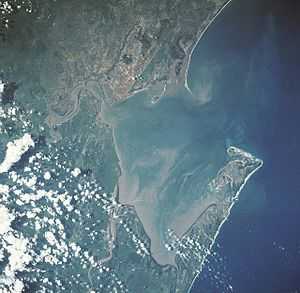Inhaca Island

Inhaca Island (Ilha da Inhaca in Portuguese) is a subtropical island of Mozambique off the East African coast.
The 52 km² island separates Maputo Bay (Baía de Maputo) to the west from the Indian Ocean off its eastern shores. The island's irregular coastline approaches mainland Machangulo Peninsula at Ponta Torres where a 500m-wide tidal race separates the two headlands. In administrative terms Inhaca is a municipal district of the municipality of Maputo, while the Machangulo peninsula is included under the Lubombo Transfrontier Conservation Area and is part of the district of Matutuíne, Maputo Province.
Geographical features
The island's dimensions are approximately 12 km (n-s) by 7 km (e-w). The highest point above sea level is the 104m Mount Inhaca on the north-eastern shoreline. The south-western peninsula is known as Ponta Punduine while Ponta Torres to the south-east approaches the mainland. Two inland swamps occur at the northerly airstrip and southern Nhaquene respectively. Besides Inhaca settlement on the western shore there are five smaller villages including Inguane, Nhaquene, Ridjeni and Tobia.
History
Despite being a part of the Portuguese Colony of Mozambique until 1975, the island of Inhaca, so close to the harbour of Maputo, was occupied by the British from 1823 until the Mac Mahon Treaty of 24 July 1875. The British used the island (amongst many others all around Africa) to patrol and control the slave traffic in the region.[1]
Ecology

The island is regular destination for ecotourists and ecological researchers. The central land area consists of cultivated fields, while grassy plains are found to the north, flanked by protected usnea-covered dune forests along the eastern and western shores. Extensive exposed mudflats fringe the western and southern shores at low tide. Three undamaged coral reefs flank the island's western perimeters, all of which are protected marine reserves. Mangroves cover large sections of the northern shores and southern Saco Bay.
Among 160 coral species are Staghorn and Plate corals. Conspicuous fish are Moray eel, Potato bass, Barracuda and Giant trevally. Others present are Brindle bass, Scorpionfish, Butterflyfish, Pufferfish, Parrotfish and Seahorses. Whale sharks and Manta rays visit in summer. Humpback Whales migrate seasonally past these shores. Resident populations of the Indo-Pacific Humpback dolphin and the Indian ocean bottlenose dolphin occur in the waters around the island. The bottlenose dolphin's abundance fluctuates seasonally, increasing during the austral winter. The humpback dolphin is more resident, living in extremely shallow inshore areas of the western and southern coasts, and form larger groups (11-14 dolphins) than recorded elsewhere in southern Africa. Bottlenose dolphins frequent the waters of the northwestern coast, and their group size varies largely from individuals and pairs to hundreds of dolphins. Two species of Sea turtles (loggerheads and leatherbacks) visit the eastern shores in summer to breed.
Inhaca is home to about 300 bird species, both resident and migratory. Species of conservation concern are the Pink-backed Pelican, Lesser Crested Tern, Crab Plover, Greater Sand Plover, Mongolian Plover, Terek Sandpiper, Southern Banded Snake Eagle, Mangrove Kingfisher, Grey-rumped Swallow and Spotted Ground-Thrush. The southerly Nhaquene Swamp and Saco Bay are strongholds for the Sooty Falcon, while Terns roost on northerly Portuguese Island 25°58′31″S 32°54′38″E / 25.97528°S 32.91056°E. Bird species of limited distribution are Rudd's Apalis, Neergaard's Sunbird and Pink-throated Twinspot. House Crows are present since the 1970s.
The sub-tropical evergreen forest on the island includes the following tree species: Sideroxylon inerme, Apodytes dimidiata, Euclea schimperi, Manilkara discolor, Dovyalis rhamnoides, Dovyalis tristis, Diospyros natalensis, Clausena anisata, Cassine papillosa, Olea africana, Ficus burtt-davyi, Ficus sansibarica, Ficus capensis, Commiphora neglecta, Commiphora schlechteri, Allophylus melanocarpus, Erythroxylon emarginatum, Vepris undulata, Deinbollia oblongifolia, Scolopia ecklonii, Thespesia populnea and Galpinia transvaalica.
Gazetteer of villages
See also
References
- A natural history of Inhaca Island, Mozambique. William Macnae, Margaret Kalk, J de Koning, 1995
- Birds of Inhaca Island, Mozambique. de Boer, WF & Bento, CM, 76pp, 1999.
- ↑ Para a História da Aliança Luso Britânica, by José be Almada, Imprensa Nacional de Lisboa 1955, pp 60-61
External links
Coordinates: 26°01′S 32°57′E / 26.017°S 32.950°E